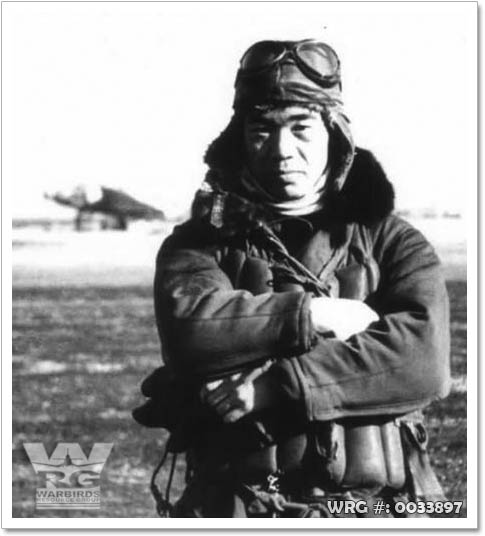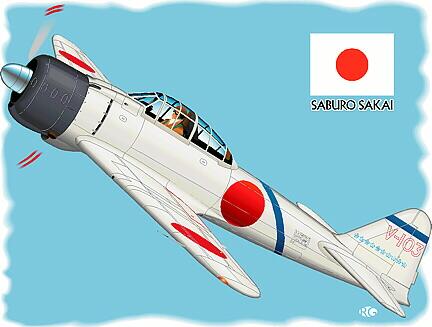WARBIRDS RESOURCE GROUP > IJARC > NAVY AVIATORS > PREVIOUS PAGE

Sabuo Sakai, China 1939.
| RANK: Petty Officer 1st Class, later Lieutenant (jg) BORN: EDUCATION: COMBAT UNITS: VICTORIES: 64 Aerial Destroyed AWARDS:Commission to Officer's rank of Lieutenant (Junior Grade) |
ASSIGNED COMBAT
AIRCRAFT*: Mitsubishi A5M4 Navy Type 96 "Claude" Carrier Fighter Mitsubishi A6M2 Model 11 Navy Type 0 (Zero) Carrier Fighter, 3-116 Mitsubishi A6M2 Model 21 Navy Type 0 (Zero) Carrier Fighter, V-103 Mitsubishi A6M2 Model 21 Navy Type 0 (Zero) Carrier Fighter, V-128 Mitsubishi A6M5 Model 52 Navy Type 0 (Zero) "Zeke" Carrier Fighter Mitsubishi J2M Navy Raiden
(Thunderbolt) "Jack" *Sakai is known to have flown these aircraft in combat - The Japanese Navy units usually did not allow the assignment of a particular aircraft to a pilot. |
REMARKS: Formed part of the elite
Tainan Ku's world famous "Ace Trio" along with Hiroyoshi Nishizawa
and Toshio Ohta. Sakai remains the top surviving ace of the Pacific Airwar.
By Paul Basar
Warrant Officer Saburo Sakai is the most famous Japanese pilot and was one of the few high scorers to survive the war. His total of 64 victories puts him in fourth place (after Warrant Officer Hiroyoshi Nishizawa, 113 victories, Lt. Tetsuzo Iwamoto, 80, and Petty Officer 1st Class Shoichi Sugita, 70). He first flew in China with the Imperial Japanese Navy, where he gained two victories, and joined the land-based naval wing at Tainan. On December 8, 1941, he flew with the rest of the Tainan Wing to attack an American air base in the Philipines.
The 45 A6M2 Zeros escorted 53 G4M Bettys until they found the air base, Clark Field. At 15,000 feet, Sakai saw five dots take off from the field, Curtiss P-40s. They made no agressive action, so Sakai left them alone and brought his fighters down to strafe. As the Zeros climbed away, the P-40s attacked. Sakai led his three plane flight to meet the American fighters and the P-40s broke off. Four flew into the smoke covering the airfield, but one turned left. Sakai fired his two machine guns and pair of cannon at it and it crashed . It was the first American plane shot down in the Philipines. Soon the Tainan Wing started to have scraps with B-17Es of the 5th Air Force. On the 25th of January, Sakai and another pilot ran into eight of the huge bombers. Knowing that many Japanese pilots had had their fighters shot to pieces by the bomber’s tail turret, he attacked from above. The 20mm. cannon carried on the Zero did the most damage and soon one of the behemoths started to smoke. The two Japanese turned on the damaged B-17, but they couldn’t shoot it down. Finally Sakai ran out of ammunition and watched as the bomber disappeared into the clouds, a probabal victory.
By February Sakai had claimed 13 Allied planes. During the spring he pushed his score. By July 22, he had reached 47 victories and on that day he claimed two more. He was flying over the beach at Buna, guarding the men landing there, when a pile of bombs exploded in the men and equipment. He soon saw a Lockheed Hudson coming through the clouds. As he attacked, the pilot of the Hudson used his bomber/transport as a fighter, chasing the Zeros. The tail gunner fired until he was killed by a lucky burst and the Hudson’s doom was sealed. Sakai jumped behind it and flamed the left engine. The Hudson crashed into the jungle, a burning mess.
As the three Zeros formed up to head home, they saw five P-39 Aircobras. The Zeros had a performance margin over the Americans, but the P-39 carried a huge 37mm. cannon in the propeller hub, which could take a Zero out with one shot. The six .50 caliber machine guns were allso deadly. But the Zeros attacked, lead by Sakai. He chased one toward a mountain, but before he could fire his guns, the American pilot baled out. Lucky for him since Sakai was ready to fill his fighter with tracers! The pilot had baled out at only 150 feet, to low for it to be safe, but he miraculously survived. With 49 victories, Sakai was in the top standings but in August the Americans invaded Guadalcanal. Covered by carriers, the Marines captured an airbase being built by the Japanese. From here the Marine and USAAC fighters attacked Japanese bombers. Meanwhile over Buna, on August 2nd, Sakai lead nine Zeros against five B-17s. The Japanese attacked and downed one right away. Sakai had forgotten to remove the safety catch on the trigger and had missed a chance on a bomber. As he climbed away from the defensive fire, he saw another B-17 go down. Before he could attack, a third was taken out. Sakai attacked one of the two remaining planes and flamed it on the first pass.
Climbing away from the burning wreck, Sakai saw three P-39s coming from the east. The eight other Zeros hadn’t noticed them, so he attacked. He got behind the P-39s, got one in his gunsight, and blew its wing off. The other Zeros turned to attack while Sakai went after the damaged B-17. Before he could get the bomber though, the Zeros finished off the P-39s and came back to help. Eventually the B-17 went down, but not before downing one of the Zeros in the process.
A few days later, the Tainan Wing escorted some bombers to Guadalcanal. Sakai attacked some of the Grumman Wildcats sent up to repel the bombers. He downed one after a long dogfight. He was then attacked by a Douglas Dauntless, normally used as a dive bomber, the Dauntless pilot used his forward firing .50 calibers against Sakai. It didn’t work and the Dauntless plunged earthward.
Sakai then noticed a formation of eight ‘Wildcats’ off in the distance. As he approached them, the back guns of the Grumman Avenger torpedo bombers shot his Zero to bits. Sakai took a bullet across the right side of his face and his left side was paralyzed, but he managed to get back to Lae, his home base. He was blinded in the right eye by that bullet.
As a result of that injury, Sakai was in the hospital until January of 1943. During March he rejoined the Tainan Wing in Japan, but when the group was stationed to Rabaul, he was left behind because his eyesight hadn’t improved. When the Wing did reach Rabaul on April 3rd , they were slaughtered by the American forces that attacked soon after: 49 Zeros in four missions. Sakai meanwhile spent a year as an instructor before being tranferred to the Yokosuka Wing, based at Iwo Jima. In one mission forty Zeros took off and only 20 came back. Sakai was among the group and but managed to escape by flying so close to the ocean that his wings dipped in the water several times. Then a few days later Sakai and the eight other remaining Zeros escorted eight G4M Bettys sent to attack the US aircraft carriers. The Bettys were armed with torpedos, while Zeros were supposed to crash into the American ships. The Bettys would do the same.
As the 17 Japanese planes neared the fleet, they were attacked by mobs of Grumman Hellcats. Only four Zeros survived along with one Betty. The bomber pilot had released his torpedos and head for home, ignoring the kamikaze order. Sakai was one of the Zero pilots to come home. He had shot down a Hellcat but had escaped in a storm cloud. He too ingnored the kamikaze order.
When he arrived in Japan after escaping from Iwo, he joined the Matsuyama Wing flying the deadly Kawanishi N1K George (the Allied name for it), armed with four 20mm. cannon. It had been designed to fight the Hellcat and in some cases it was superior, but it had short range so it was worthless as a carrier fighter. Before Sakai could fly these into combat, he was transfered back to the Yokosuka Wing flying Mitsubishi J3M Jacks. Heavily armed and fast, Sakai flew them with some success against the B-29s raiding Japan. Soon though, the bombers were escorted by the best American fighter, the P-51 Mustang. The Jack was unmaneuverable and it was often shot down by the Mustang in a dogfight.
On his last mission, Sakai and nine other pilots took off to intercept the
B-29s during the night of August 13, 1945. They all attacked one B-29 and shot
it down over the ocean. Then a few days later Japan surrendered. Sakai had
achieved 64 victories. He wrote a book after the war called
"Samuria", based on his wartime experiences.

Saburo Sakai
WARBIRDS RESOURCE GROUP > IJARC > NAVY AVIATORS > PREVIOUS PAGE
